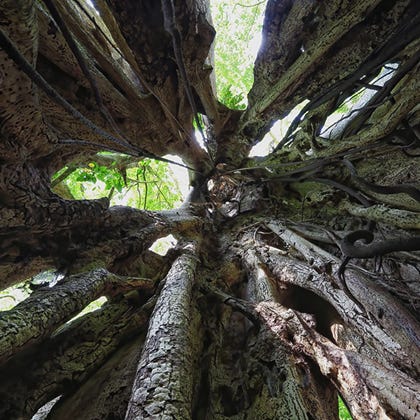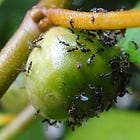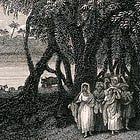Planet Ficus Monthly Roundup #6
Sacred bats in India. Lightbulb leaves. Fig tree rituals in Africa. Forest restoration and protection in Borneo. An adept tree climber. And more.
Welcome to the Planet Ficus Monthly Roundup
Each month, I’ll bring you stories from around the world that reveal just how extraordinary fig trees are — not just biologically, but culturally, spiritually and artistically.
In this roundup, you’ll find: A curse in Kenya, nature’s lightbulbs, sacred bats in India, prayers for rain in Zimbabwe, forest restoration in Borneo, a Zulu death rite, a climber in the Costa Rican canopy — and more.
This variety is not a coincidence — it’s evidence that fig trees are everywhere in the human story and central to many ecosystems and cultures.
My mission with these roundups is simple: To show you that fig trees are the most interesting, important and awe-inspiring plants on the planet. Thanks for joining me on this journey. I hope these stories surprise and delight you, and maybe even change the way you see the natural world.
Let’s dive in.
Feature Story: Faith, Figs and Fruit Bats
From India comes an example of hyperlocal conservation rooted in faith and centred on a venerable fig tree. The tree is a banyan (Ficus benghalensis) in Perambur village in the state of Tamil Nadu. As well as having a shrine to Hindu deity Lord Muneeswaran, it is home to hundreds of fruit bats, which the villagers consider sacred. To protect the bats, they avoid making excess noise or burning waste near the tree — unlike in many places across India, no firecrackers are lit here to celebrate Diwali.
By protecting the bats and their banyan, the villagers are securing a vital cog in the machinery of their local ecosystem. The banyan feeds dozens of species of seed dispersing birds and mammals. The fruit bats themselves disperse the seeds of the fig tree and many other species besides.
With growing interest in the tree from tourists and birdwatchers, the villagers now have a dilemma. Some want to develop the site for ecotourism, with a road replacing a muddy track. Others say this will disturb the bats and harm the local ecosystem. A forestry official suggests a better plan: creating an observation station a safe distance from the tree. By balancing reverence, conservation and livelihood needs, the villagers are writing a modern story of coexistence under an ancient tree.
Science, Ecology and Conservation
Anubha Jain interviewed fig biologist Renee Borges about the partnership between Ficus species and fig-wasps that makes figs keystone resources — and about the vulnerability of this partnership to climate change.
From the Philippines comes more evidence that fig trees left standing in disturbed forest landscapes are vital focal points for seed dispersing animals whose daily journeys help forests to recover. Researchers in Benguet province showed that the number and diversity of saplings growing beneath Ficus minahassae trees is much greater than that below the pine trees that dominate local forests. They also showed how the trees enrich the soil beneath them with nutrients from their fallen leaves, helping saplings of other species to survive.

In Malaysian Borneo, the Forestry Department in the state of Sabah held an event to promote the use of fig trees in rainforest restoration and biodiversity conservation. It included presentations from BORA and 1StopBorneo Wildlife — two organizations whose amazing work I have written about here at Planet Ficus.
The leaves of strangler figs contain structures that act like lightbulbs, increasing the amount of solar energy the trees can capture, writes Quentin Phillipps. These optical systems are called cystoliths and they are microscopic — just 0.1mm wide. A rod of silica serves as a fibre-optic cable, directing sunlight from the leaf’s upper surface to a blob of calcite that scatters the light to surrounding cells, which use it to convert carbon dioxide into sugars that power the plant.
Food and Health
Food trials in India showed that dry fig powder is a promising natural substitute for refined sugar — one that is also high in fibre, calcium and potassium.
Planters, Protectors, Presidents
In India, footage went viral on social media after an elderly woman in a village in the state of Chhattisgarh was filmed crying inconsolably as she clutched the stump of a recently felled fig tree. Devla Bai Patel, aged over 90, had planted the peepal tree (Ficus religiosa) more than 20 years earlier, and had watered and prayed at it daily. Locals told journalists that she had treated the tree as if it were her own child. The Indian Express reports that Patel’s fellow villagers, who used to seek blessings from the tree, performed a ritual to seek its forgiveness. They presented Patel with a Ficus religiosa sapling which she planted to replace her fallen fig tree. The police have arrested two men for ‘defiling a place of worship’.
Few people — if any — have planted more fig trees than Swami Prem Parivartan, an environmentalist in India better known as Peepal Baba: a name derived from that of the peepal fig tree (Ficus religiosa). Ananya Ganotra wrote about how Peepal Baba and his organization, the Give Me Trees Trust, have planted 24 million trees across India — many of them peepals or banyan figs (Ficus benghalensis).
On a visit to India, Bhutan’s President Ukhnaagiin Khurelsukh planted a banyan tree (Ficus benghalensis) in honour of his late mother. India’s Prime Minister Narendra Modi said the fig tree would, “stand as a symbol of our deep friendship and our shared commitment to the environment, for generations to come.”

In Indonesia, former President Megawati Soekarnoputri planted a sacred bodhi tree (Ficus religiosa) at Gadjah Mada University. The dean of the university’s Faculty of Forestry, Sigit Sunarta, said the species was chosen for its religious and ecological importance.
Here at Planet Ficus, I wrote about new research in Borneo exploring how an Iban community’s taboo against harming strangler figs — born of belief in forest spirits — preserves life above and below the canopy.
A Climber’s Curiosity in Costa Rica
I love finding out about people whose lives have been shaped by fig trees. An article by Ash Routen introduced me to an adventurous soul called Noah Kane who has become adept at climbing into the canopy of cloud forests in Costa Rica by hauling himself up the aerial roots of strangler figs. Kane has produced a series of videos about his exploits. They include one about spending Christmas eve camping in the crown of a strangler fig, some 25m above the ground, and a lush documentary called Climbing Giants featuring biologists who also climb trees to seek answers in the canopy.

Faith, Ritual and Sacred Fig Trees
Ivan Zhakata reported on scenes in Goromonzi, Zimbabwe, where villagers sang, beat drums and gathered under a giant fig tree to pray to their ancestors for rains and good harvests — reviving a ceremony that had been abandoned for several years.
After the sudden death in Paris of South Africa’s Ambassador to France, early in October, family members who repatriated his body brought a branch of a fig tree to accompany it and collect his spirit, following a Zulu tradition.
In Kenya, two fig trees accused of causing inter-tribal conflict must soon be felled, says elders from both communities. Evans Jaola reported that members of the Sabaot and Bukusu communities blame the trees for decades of cattle rustling and violent clashes in Bungoma and Trans Nzoia counties. Lore states that the curse originated during a ten-year war between the two groups that began in 1892 — when two leaders from opposing sides died and were buried in a single grave. To remove the curse, the trees should have been cut down in 1992, but political violence prevented this. Elders have petitioned a local court to seek government protection during traditional cleansing rituals before and after the trees are cut down, as some local leaders oppose the ceremonial felling.
Hundreds of kilometres away, in Kirangi village in Kiambu county, elders from the Kikuyu community performed a ritual to appease a sacred fig tree they wanted to cut down to make way for the wall of a Catholic church. On 30 October, the elders poured a traditional alcoholic drink at the base of the tree, chanted prayers and roasted a slaughtered lamb to ashes beneath the tree in a ritual of purification. As Mathew Ndung’u reported, the elders interpreted the rising smoke as a sign that the Kikuyu god Ngai had accepted their request.
Thank you for reading
Thanks for being part of Planet Ficus. If you liked what you read, consider sharing it with someone who might enjoy these stories too — and if you haven’t already, subscribe for future editions. Together we can grow a forest of readers.






